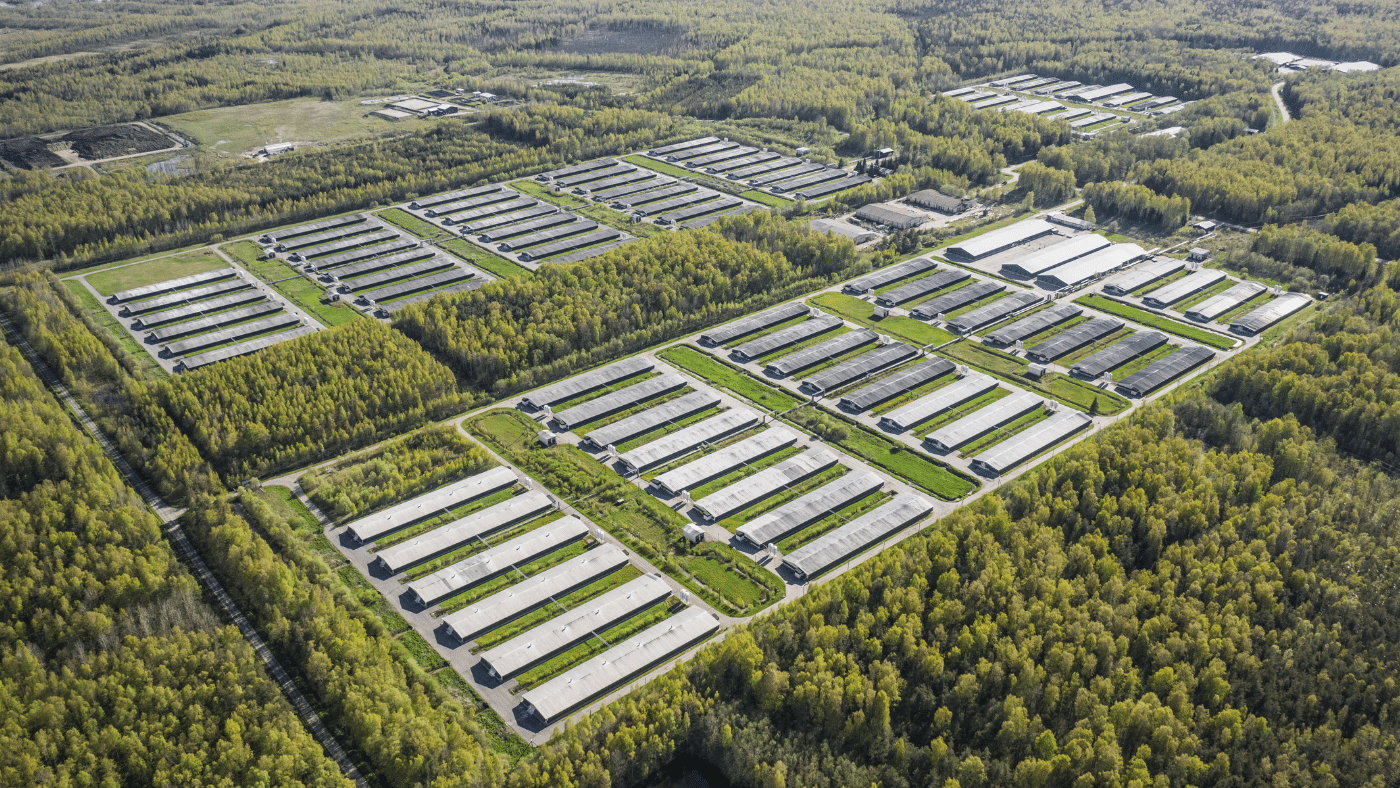An animal feeding operation (AFO), as defined by the U.S. Department of Agriculture (USDA) is an operation in which:
(1) animals are kept and raised in confined situations
(2) animals, feed, manure and urine, dead animals and production operations are maintained on a small land area
(3) no grazing is allowed; feed is brought to the animals.
A concentrated animal feeding operation, or CAFO (popularly known as a ”factory farm”), as also defined by the USDA, is an AFO in which over 1,000 ”animal units” are confined for over 45 days a year. An animal unit is the equivalent of 1,000 pounds of “live” animal weight. To put this in perspective, one thousand animal units equates to
- 700 dairy cows
- 1,000 meat cows
- 2,500 pigs weighing more than 55 pounds
- 10,000 pigs weighing under 55 pounds
- 10,000 sheep
- 55,000 turkeys
- 125,000 chickens
- 82,000 egg-laying hens
The U.S. Environmental Protection Agency (EPA) further defines small, medium and large CAFOs based on the specific types of livestock and the number of individual animals.
A CAFO is typically made up of one or more large, covered barns, typically located next to a waste lagoon, into which manure slurry is discharged and the waste anaerobically degraded. Larger CAFOs may have dozens of barns, each with its own waste lagoon. In addition to lagoons, many CAFOs use “spray fields“: animal waste is pumped into irrigation equipment that sprays the waste onto open fields. Manure may also be removed from lagoons and applied directly to land.
Currently there are approximately 25,000 CAFOs in the U.S. and USDA data show that the average CAFO size is increasing, while the number of individual CAFOs is declining. Livestock production has become increasingly dominated by CAFOs in the U.S. and other parts of the world. On average, 90% of meat and eggs in the U.S. comes from CAFOs.
The benefits of CAFOs are primarily economic:
- larger farms have lower production costs than smaller farms
- CAFOs promote economic development in economically depressed rural communities
- CAFOs can help consumers by lowering prices for produce
The Downsides of CAFOs: Environmental, Biological and Socio-Economic
While efficient, there are significant environmental issues and concerns associated with CAFOs, primarily related to waste generation and management. CAFOs produce 335 million tons of manure annually in the U.S. If not managed properly, pollutants can enter the air, contaminate groundwater and/or runoff into and contaminate surface water bodies.
Harmful pollutants and chemicals of concern associated with CAFOs include nitrogen and phosphorus (nutrients), pathogens (disease-causing bacteria and viruses), volatile odorous compounds (hydrogen sulfide, ammonia), and greenhouse gases (carbon dioxide, methane). In fact, livestock waste is the largest source of agricultural greenhouse gas emissions.
A major concern related to CAFOs is the impact of these operations on water. The Clean Water Act (CWA)is a federal law that prohibits the discharge of any pollutant by any person from any point source, into navigable waters of the U.S., except for those who obtain requisite National Pollution Discharge Elimination System (NPDES) permits, which set
- limits on what can be discharged
- monitoring and reporting requirements, and
- other provisions to ensure that the discharge does not impair water quality or people’s health
It is important to note that small CAFOs and some medium CAFOs are considered “nonpoint sources,” and are not held to the same standards as large CAFOs, even when they discharge pollutants into U.S. waters. The large amounts of animal waste from CAFOs present a risk to water quality and aquatic ecosystems. States with high concentrations of CAFOs experience, on average, 20 to 30 serious water quality problems per year as a result of inadequate manure management.
Flooding near CAFOs during hurricanes and major storms is also a concern. A CAFO is responsible for one of the largest environmental spills in U.S. history when, in 1998, a 3-acre CAFO lagoon ruptured in North Carolina. The spill released 25.8 million gallons of manure into the New River and resulted in the killing of 10 million fish. The spill is also believed to have contributed to an outbreak of Pfiesteria pisccicida, causing health problems for residents.
In addition to impairing water quality, CAFOs can also be significant sources of harmful air emissions. Odor complaints are common and gaseous emissions can cause a number of health effects (e.g., asthma, respiratory problems, eye irritation, nausea). The federal Clean Air Act (CAA) is the principal U.S. law regulating air pollution emissions. Although the U.S. Environmental Protection Agency (EPA) and States authorized to implement the CAA have the authority to require that CAFOs measure and control their emissions, CAA requirements are often inadequately enforced at CAFOs.
CAFOs are also increasingly using antibiotics, to both treat and prevent illness in livestock. Even if stock are not sick, CAFOs will incorporate low doses of antibiotics into feed to reduce the likelihood of infection, which increases the rate of growth and size in animals, and thus production. The World Health Organization (WHO) has recommended that the non-therapeutic use of antibiotics in animal husbandry be reevaluated, as it contributes to the emergence of resistant bacteria that can spread to humans.
Finally, there are socio-economic impacts: property values near CAFOs may be reduced by up to 40% depending on distance, wind direction and other factors. The diminution in property values is due to CAFO odors, flies and a negative impact on the quality of life for nearby residents.
Regulatory Controls Designed to Reduce the Environmental Impact
The EPA specifies the maximum allowable amounts of pollution that can be discharged by CAFOs, termed “effluent limitations guidelines” (ELGs). The requirements can include both numeric discharge limits, as well as best management practices and technology-based standards. The EPA first promulgated ELGs for CAFOs in 1976. A 2003 rule issued by the EPA updated and modified the applicable ELGs for CAFOs, among other things. In 2005, the court decision in Waterkeeper Alliance v. EPA struck down parts of the 2003 rule and the EPA responded by issuing a revised, final rule in 2008.
The 2008 rule:
(1) requires a NPDES permit for any CAFO that has a discharge, with enforceable rules regarding limits, monitoring and reporting requirements, etc. incorporated into the permit
(2) requires CAFOs to have a Comprehensive Nutrient Management Plan (CNMP) addressing feed management, manure handling and storage, land application of manure, record keeping and activities that utilize manure
(3) requires establishment of Best Management Practices (BMPs)
(4) specifies two approaches that a CAFO may use to identify the annual maximum allowable rates of application of manure, litter and process wastewater to fields and crops.
Complex Issues Require Expert Insight When Insurance Claims Arise
CAFO-related claims made on environmental/pollution insurance policies may be related to: soil contamination, groundwater contamination, surface water contamination and/or odors (nuisance claims).
The Vertex Companies, LLC (VERTEX), with an extensive staff of professional engineers, professional geologists, environmental scientists, and remediation specialists, can provide assistance with CAFO-related contamination issues, including investigation of impacts to the environment, evaluation of laboratory analytical data and associated regulatory requirements, and the selection and implementation of an appropriate mitigation/remediation approach based on site-specific impacts and geologic/hydrogeologic settings. VERTEX can also assist insurance carriers with the evaluation of CAFO-related claims made on pollution insurance policies. For more information, contact Lawrence Daniels (ldaniels@vertexeng.com) or submit an inquiry.




